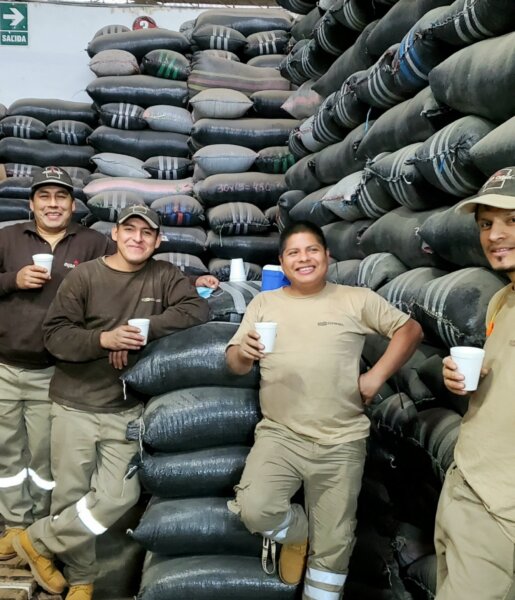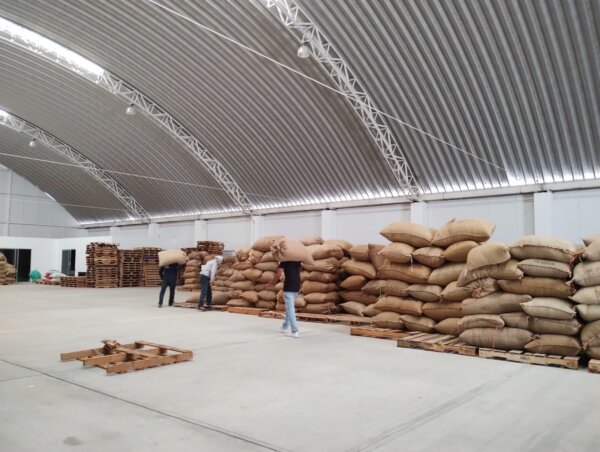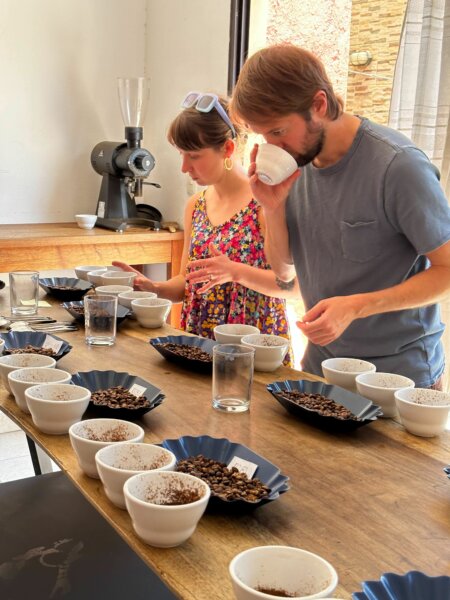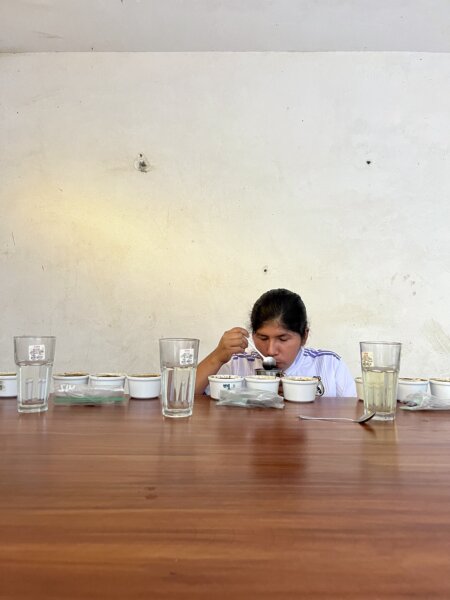When we meet new prospective partners at any link of the supply chain, one of the first things we usually talk about is our headquarters in Lima, Peru, and Oaxaca, Mexico, and the unique way these labs facilitate our sourcing model. Those offices are not just essential to our work, but to who we are. We see ourselves as great partners in delivering coffee to domestic roasting clients, but our real value add occurs long before the coffee arrives in the US.
Our headquarters in Lima and Oaxaca are a primary force that allows us to control quality from the moment coffee leaves a farmer, through the dry milling process, through loading at the port of origin. They meet a host of operational needs that are core to our functioning, vastly enhancing our speed and efficiency of cupping and processing through samples, facilitating our active presence and participation at the mill, informing our extremely hands-on approach to logistics, offering a place for roaster partners to actively participate in our sourcing model, and many more.
- We’re able to obtain and promptly cup offer samples, then send feedback and approvals to producers and/or producer associations immediately.
- We’re able to advise on and ensure proper storage of coffee from harvest through shipment.
- We’re able to make sure that collection happens as scheduled despite copious obstacles that arise over the course of the season.
- We actively manage each coffee through its milling process, ensuring not just quality but traceability.
- We do the hard work of extremely active logistics management, getting each coffee to port and afloat to its destination.
- When coffees arrive, we’re at our Berkeley headquarters ready to cup arrivals and manage QC through the rest of their journey.
- Meanwhile, back at origin, we spend the off-season meeting with producers to calibrate on quality analysis, share feedback, and improve processes.
In this 2-part series we dig into each one of these needs and how our HQs in Lima and Oaxaca help meet them. In Pt 1, we covered why we opened our Lima and Oaxaca headquarters, how they help us increase the speed and efficiency of quality analysis in cupping and sample processing, and how they allow us to deepen our quality control protocols along the entire supply chain.
In Pt 2, we’ll explore direct involvement at the dry mill and hands-on logistics as core facets of quality control, and the necessity of our Lima and Oaxaca HQs as a tool for roaster partners to participate in our model.
Quality Control at the Dry Mill
 As we covered in a recent piece, in-person supervising of milling is mission-critical to what we do in ensuring consistency and repeatability of quality while minimizing rejected volume.
As we covered in a recent piece, in-person supervising of milling is mission-critical to what we do in ensuring consistency and repeatability of quality while minimizing rejected volume.
Similarly to the extra personnel-hours required to cup smallholder lots individually, cupping milled samples representing small chops of coffee as milling proceeds is a time-consuming, labor-intensive process that we’ve learned is fully worth the return. It’s another thing you truly can’t do from afar the way we do it in-country—cupping a single milled sample just isn’t the same.
Our close physical proximity to the mills allows us to spend as much time there as we need to, rotate personnel in and out of the mill to maximize their focus over long, strenuous shifts, and shows mill personnel how much we care about quality and how important it is to mill to our quality specifications. It also strengthens our relationships with mill personnel; being in regular contact with them means they can quickly tell us if the plant has slots available and request reservations for us, so we can meet our milling needs even at the busiest parts of the season.
Coordinating Logistics to Maximize Quality
 Logistics are one of the most critical junctures where we inject value into the supply chain. Delivering a coffee in optimal condition, exactly on time involves thousands of steps that have to be coordinated in detail between and beyond the team. Each communication gap or untimely communication directly impacts the entire chain.
Logistics are one of the most critical junctures where we inject value into the supply chain. Delivering a coffee in optimal condition, exactly on time involves thousands of steps that have to be coordinated in detail between and beyond the team. Each communication gap or untimely communication directly impacts the entire chain.
At the lab, there’s a lot more we do to coordinate logistics than just quick preship approvals. Logistics coordination throughout Peru and Mexico season is an all-day, nights-and-weekends job that involves putting out fires as they pop up along a complex terrain.
Logistics coordination entails:
- Getting coffee from the field to Lima and Oaxaca (in Peru and Mexico seasons, respectively).
- Getting lots contracted and approved.
- Putting physical contracts in place.
- Getting burlap coffee sacks printed with lot specifics.
- Assessing options for different shipping lines and finding the most direct and shortest even when they cost a little more; getting these approved by all necessary parties.
- Obtaining reservations on shipping vessels.
- Making appointments for specific coffee to ship at specific date.
- Getting exportation paperwork set up.
- Aligning dry-milling dates so coffees can export asap.
Whenever any of these dates or appointments changes or falls through, which happens frequently through the season, it has to be addressed as efficiently as possible. During the export seasons, these appointments frequently change and are even canceled by the dry-mill or exporter due to bottlenecks as they process literal tons of coffee. Whenever any of these dates fall through, we have to make further arrangements as quickly and efficiently as possible. Close proximity to and communication with the coffee, growing regions, and ports makes rebooking appointments a lot easier and exporting a lot faster.
It’s work that’s heavily aided by local team members who intimately know the physical geography and traffic patterns of each region and can anticipate roadblocks due to weather (rains, mudslides, frosts, etc.) and other conditions such as protests, parades, celebrations or construction, all of which have the potential to cause shipment disruptions in ways unseen from abroad. We maintain a map of all these possibilities as we go through each season, plan heavily, and communicate constantly in order to make sure the coffees move quickly around every possibility.
Hosting Roaster Partners
 Another crucial aspect of our Lima and Oaxaca headquarters is that they offer a place for roaster partners to see the specifics of how we source our coffee and participate actively in our sourcing model. These headquarters are a base of operations, but they’re also a fantastic way to be present and experience firsthand what sourcing means to us. They offer a home base for roasters to cup and make real-time buying decisions, participate in constructing bespoke lots tailored to their needs, meet with producers and associations, join us on field trips, and experience an immersion into the surrounding areas.
Another crucial aspect of our Lima and Oaxaca headquarters is that they offer a place for roaster partners to see the specifics of how we source our coffee and participate actively in our sourcing model. These headquarters are a base of operations, but they’re also a fantastic way to be present and experience firsthand what sourcing means to us. They offer a home base for roasters to cup and make real-time buying decisions, participate in constructing bespoke lots tailored to their needs, meet with producers and associations, join us on field trips, and experience an immersion into the surrounding areas.
A Worthwhile Investment
 Our on-the-ground presence in Lima and Oaxaca is a natural outgrowth of the way we operate. Opening these headquarters and staffing them has been a considerable investment, and one that has paid huge dividends in growth in Peru and Mexico, as well as surrounding regions like Bolivia.
Our on-the-ground presence in Lima and Oaxaca is a natural outgrowth of the way we operate. Opening these headquarters and staffing them has been a considerable investment, and one that has paid huge dividends in growth in Peru and Mexico, as well as surrounding regions like Bolivia.
That growth in Peru and Mexico stands on a foundation of our consistent physical presence in areas off the beaten path, our efficiency in processing samples, our active participation at the dry mill to maximize quality, our dynamic and effective logistics work, and our ability to let roaster partners partake in these processes when they visit.
Interested in sourcing coffee with us? Reach out at info@redfoxcoffeemerchants.com. To learn more about our work, check out our journal and follow us on Instagram @redfoxcoffeemerchants.
